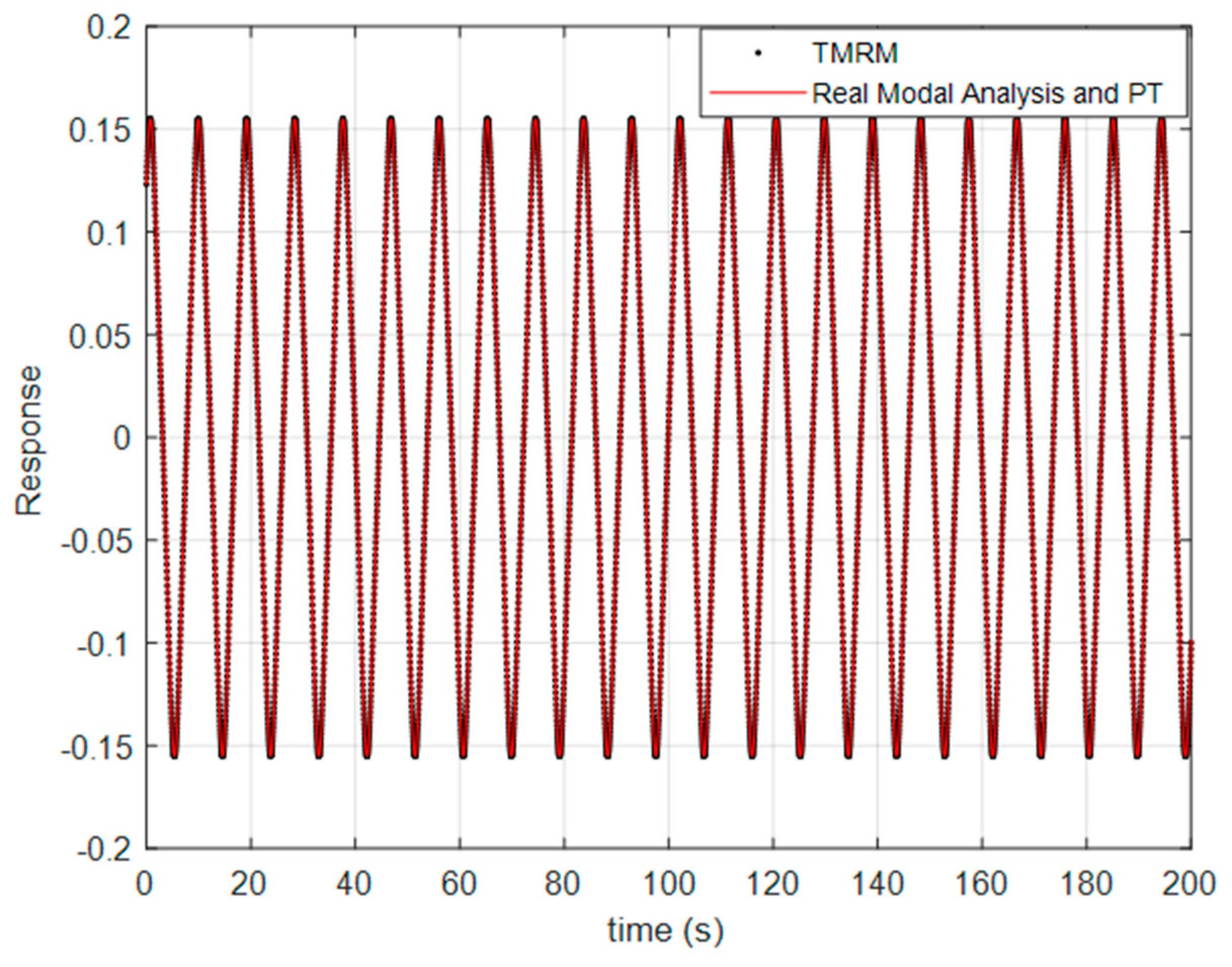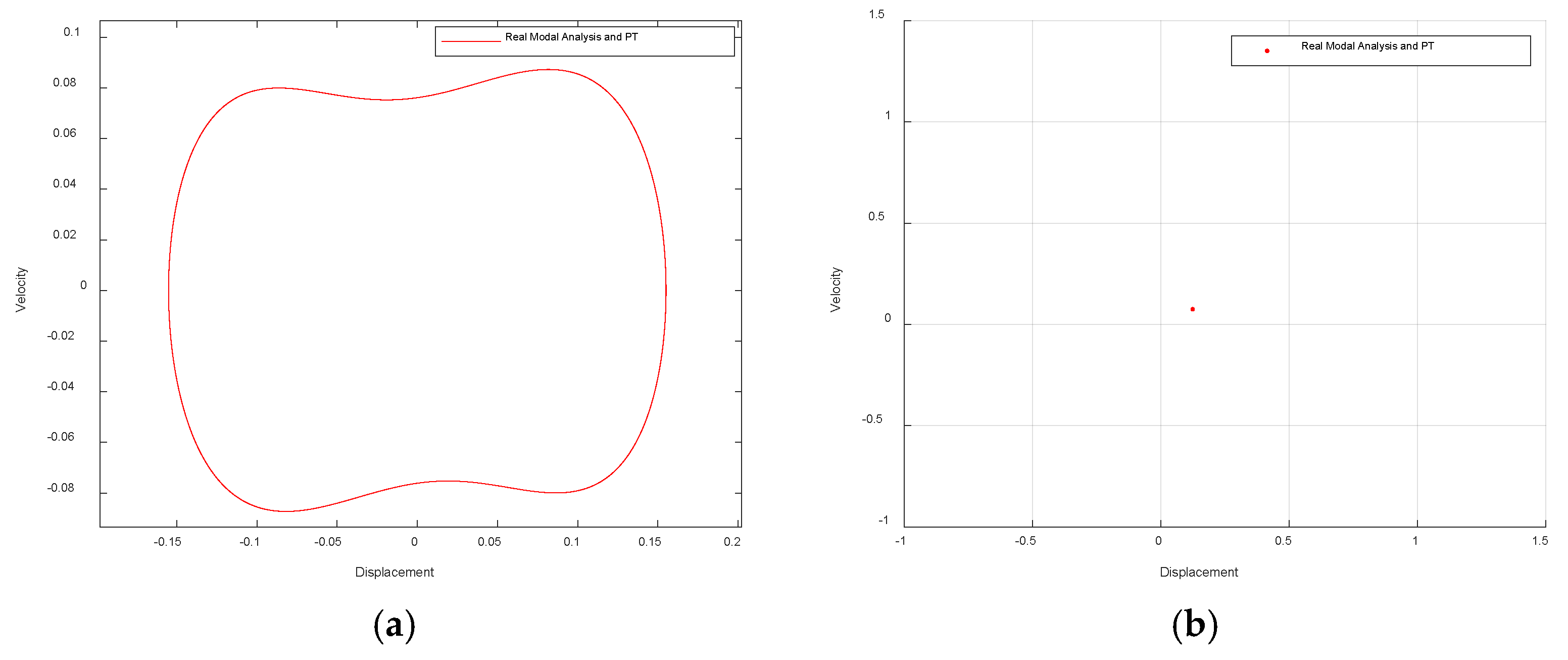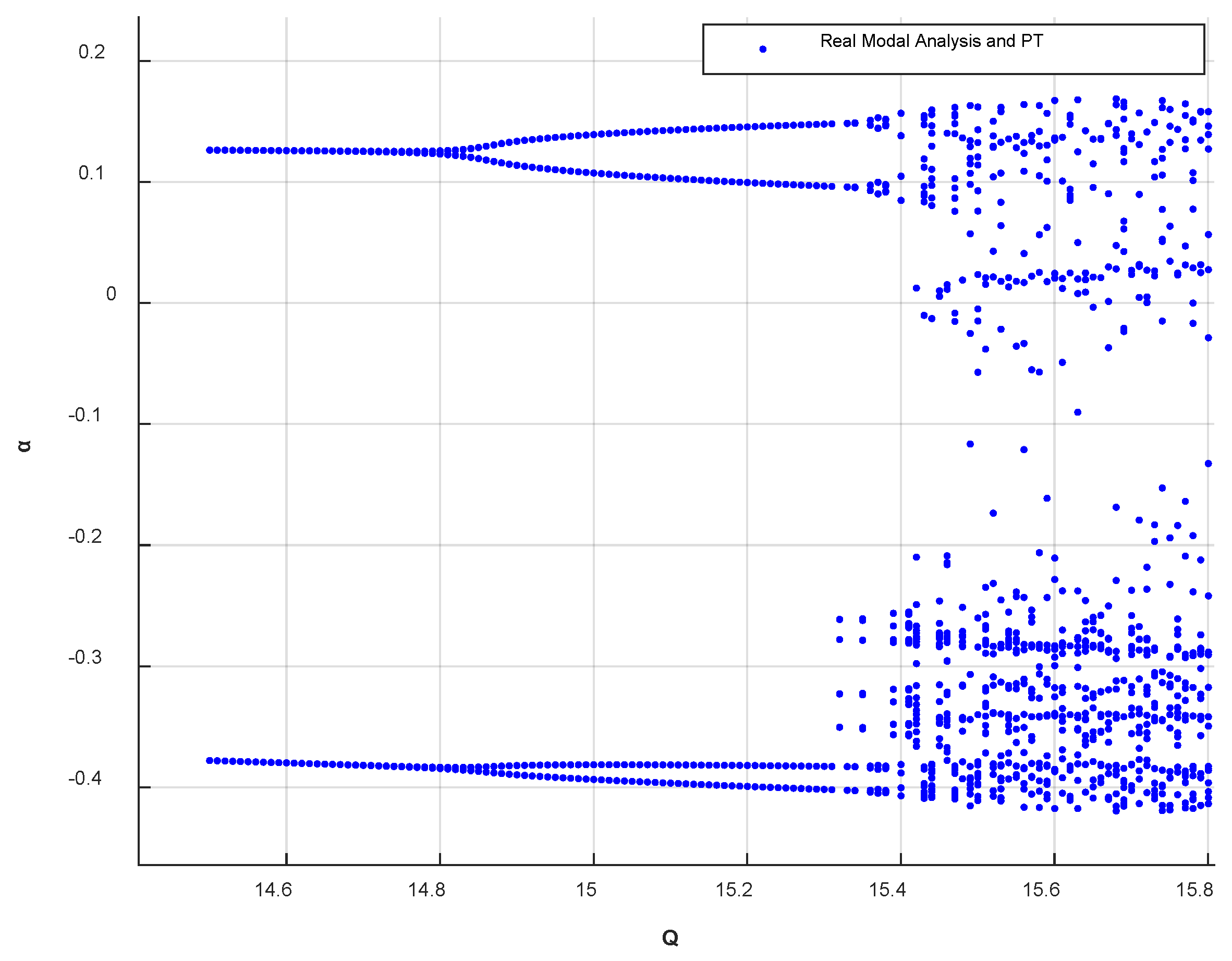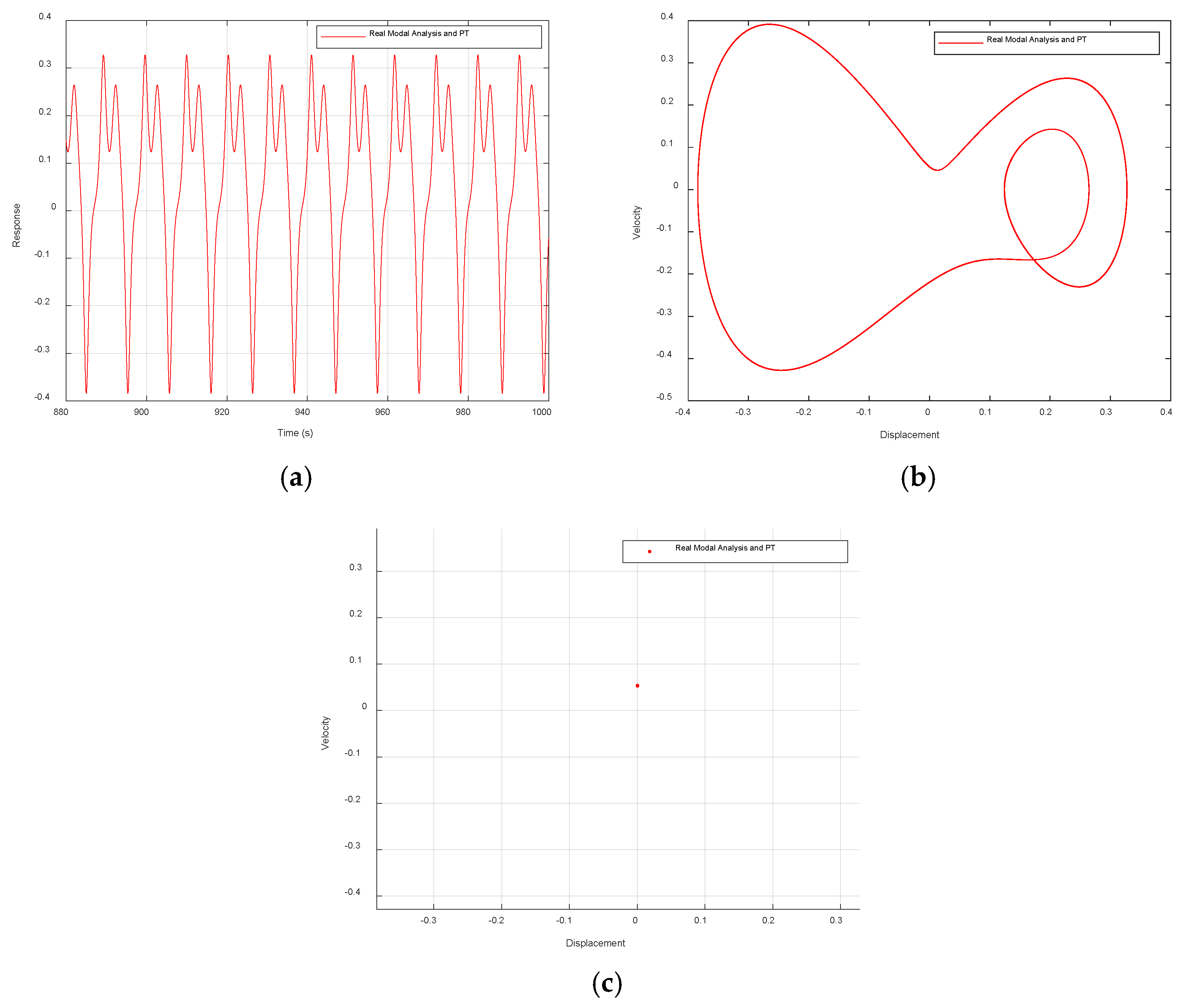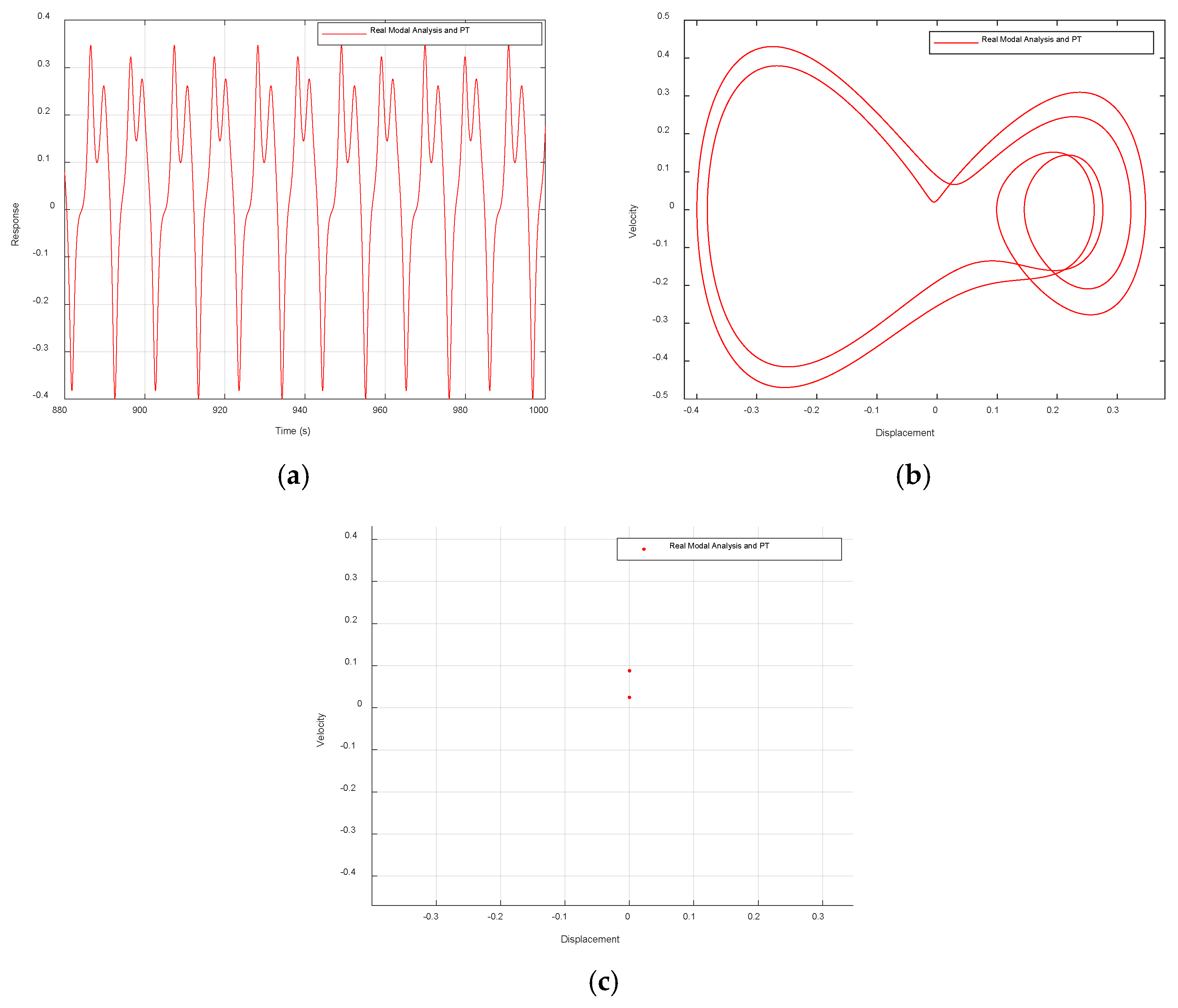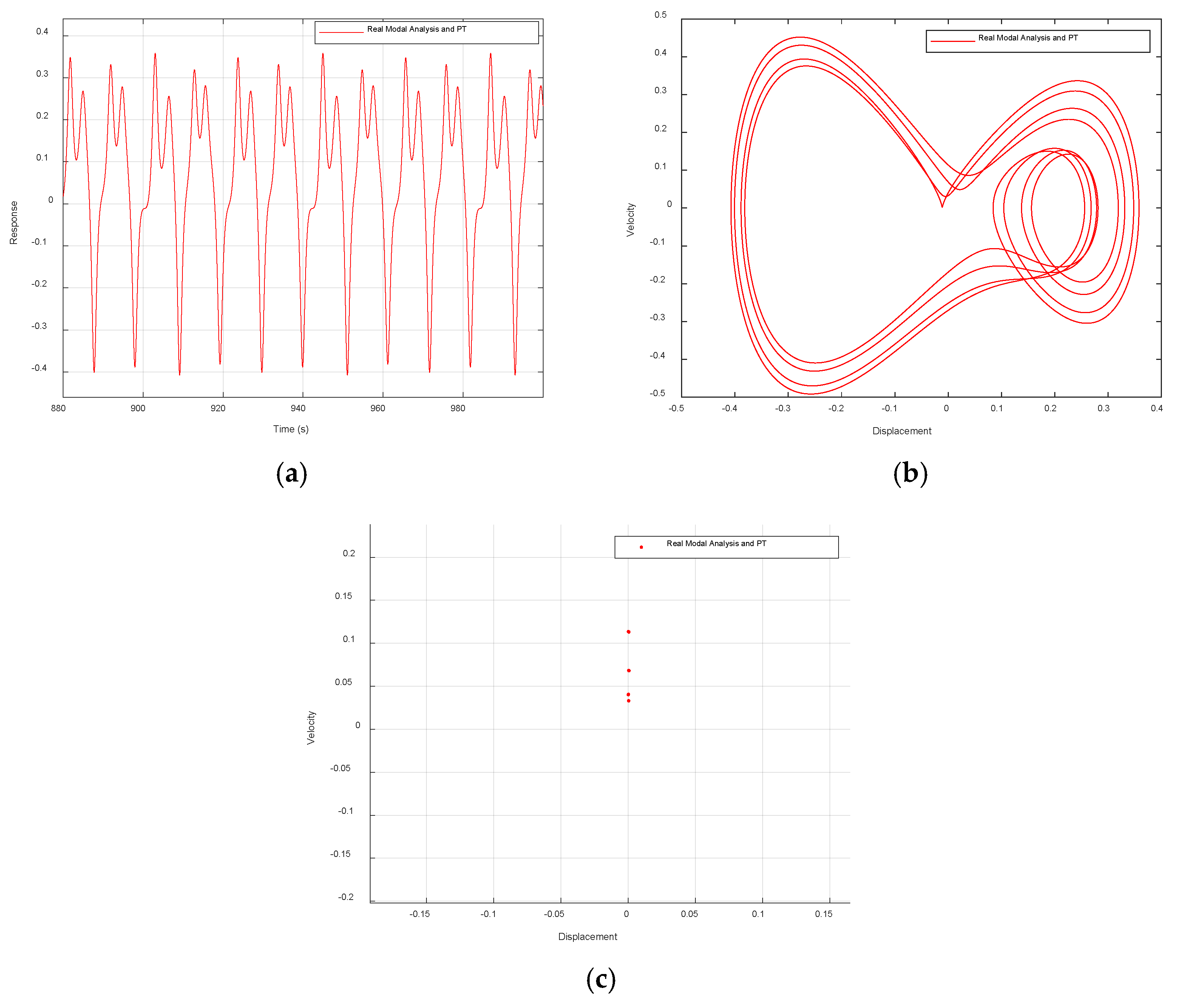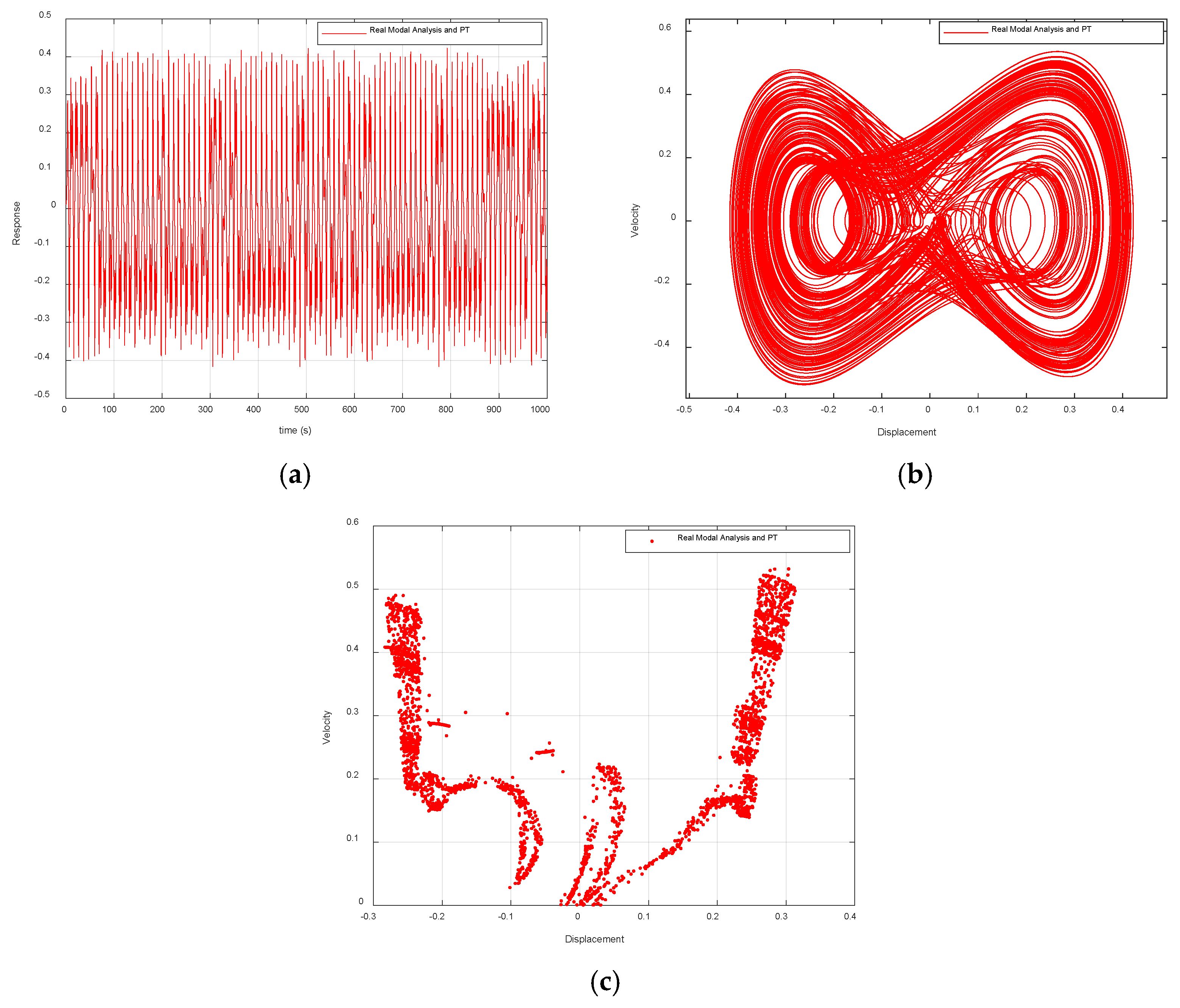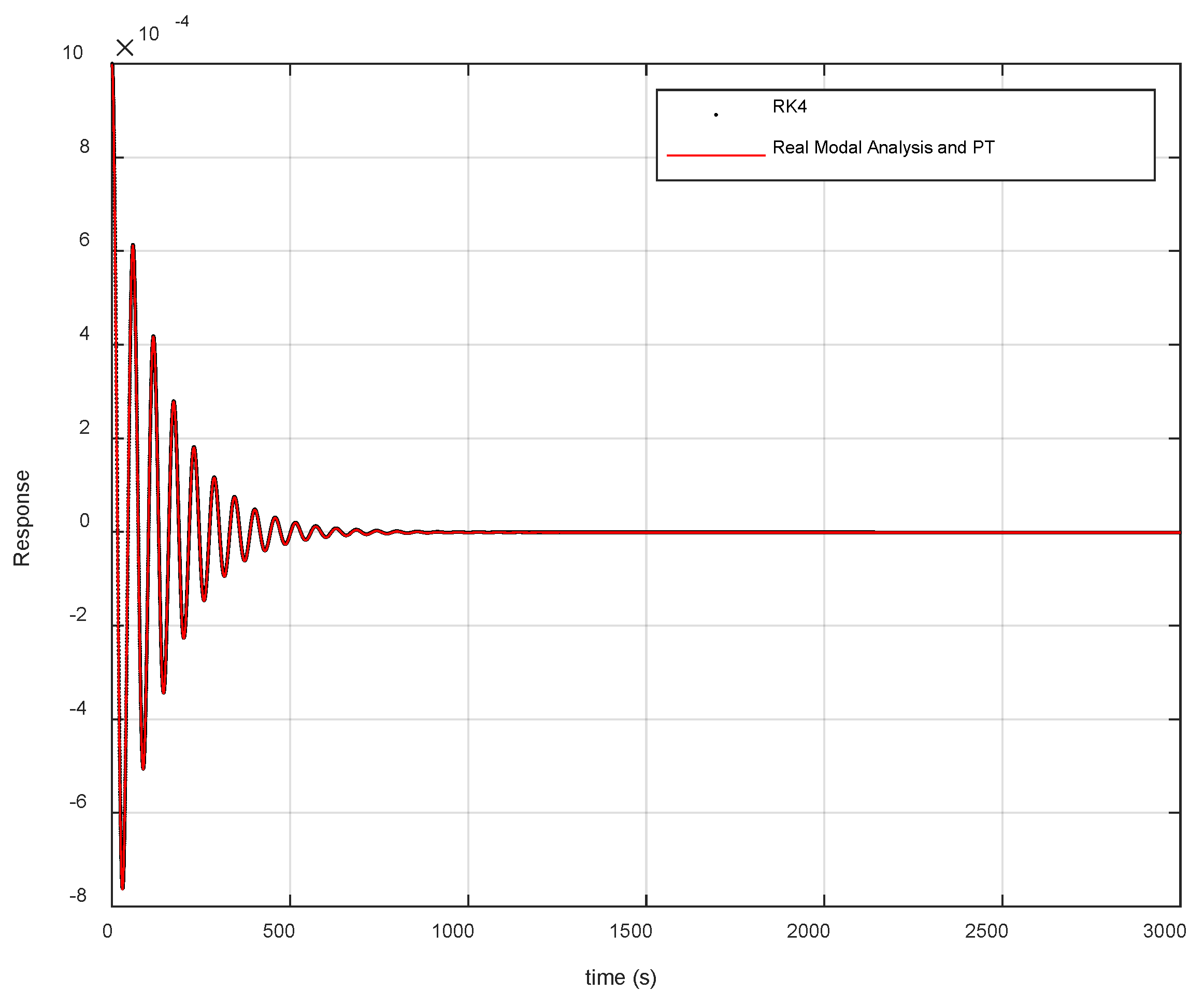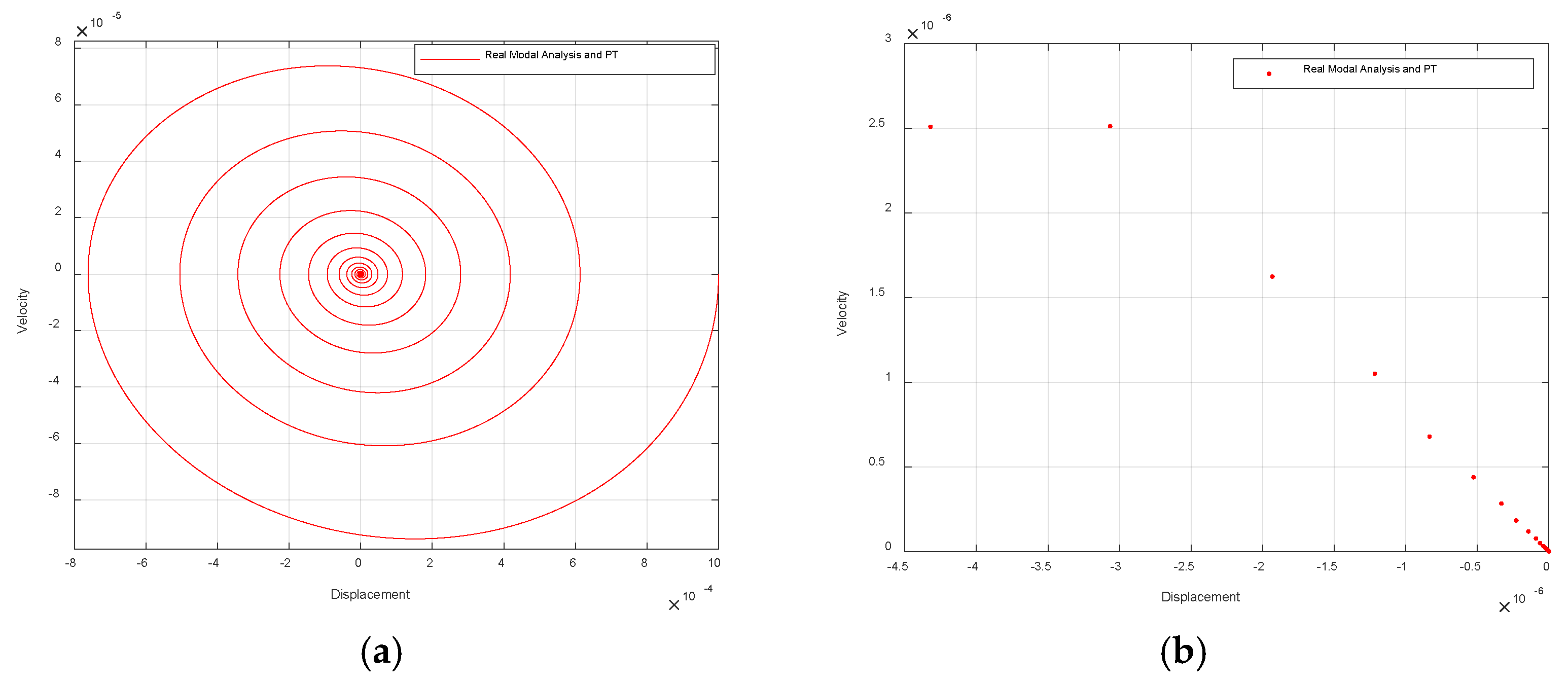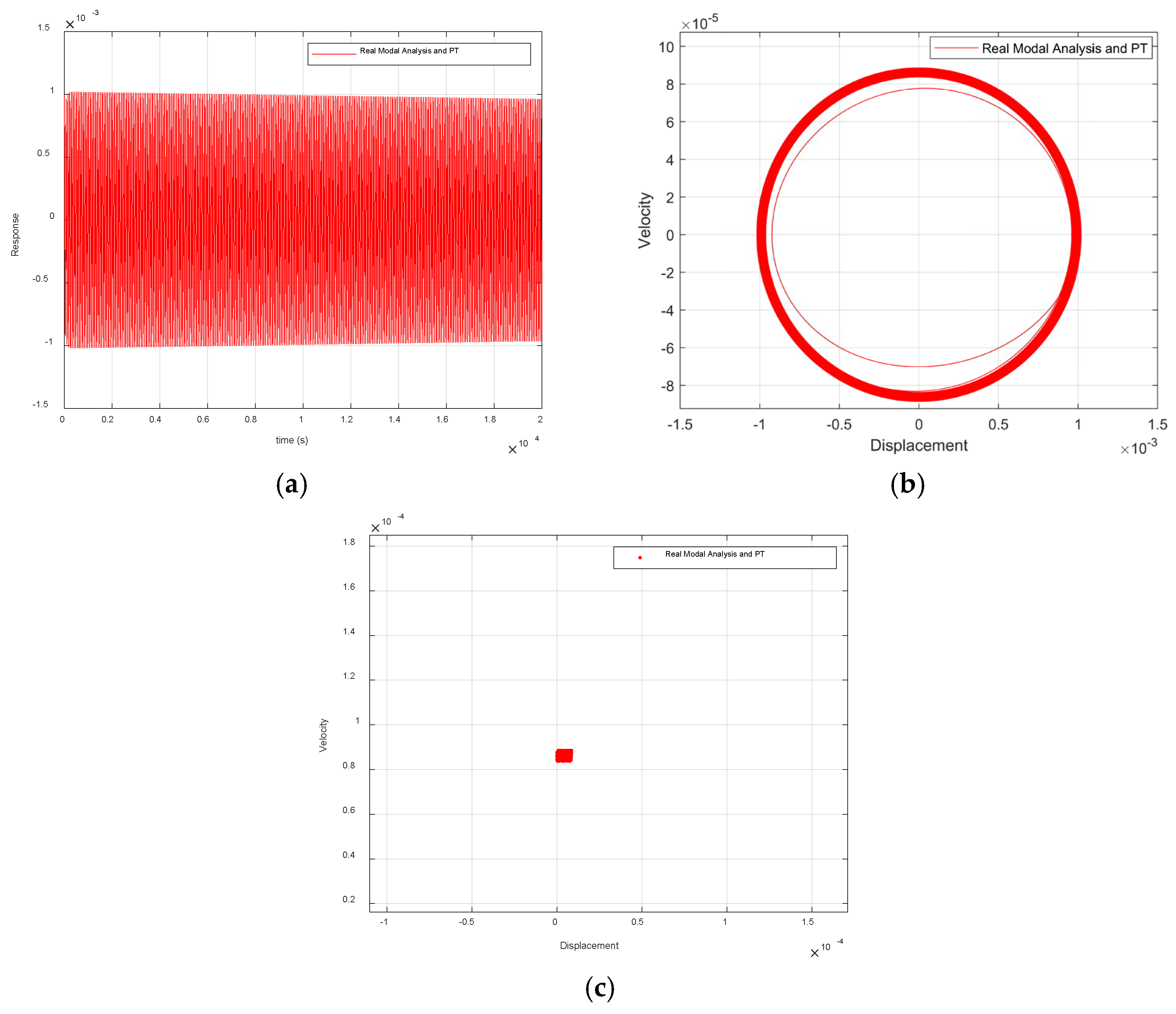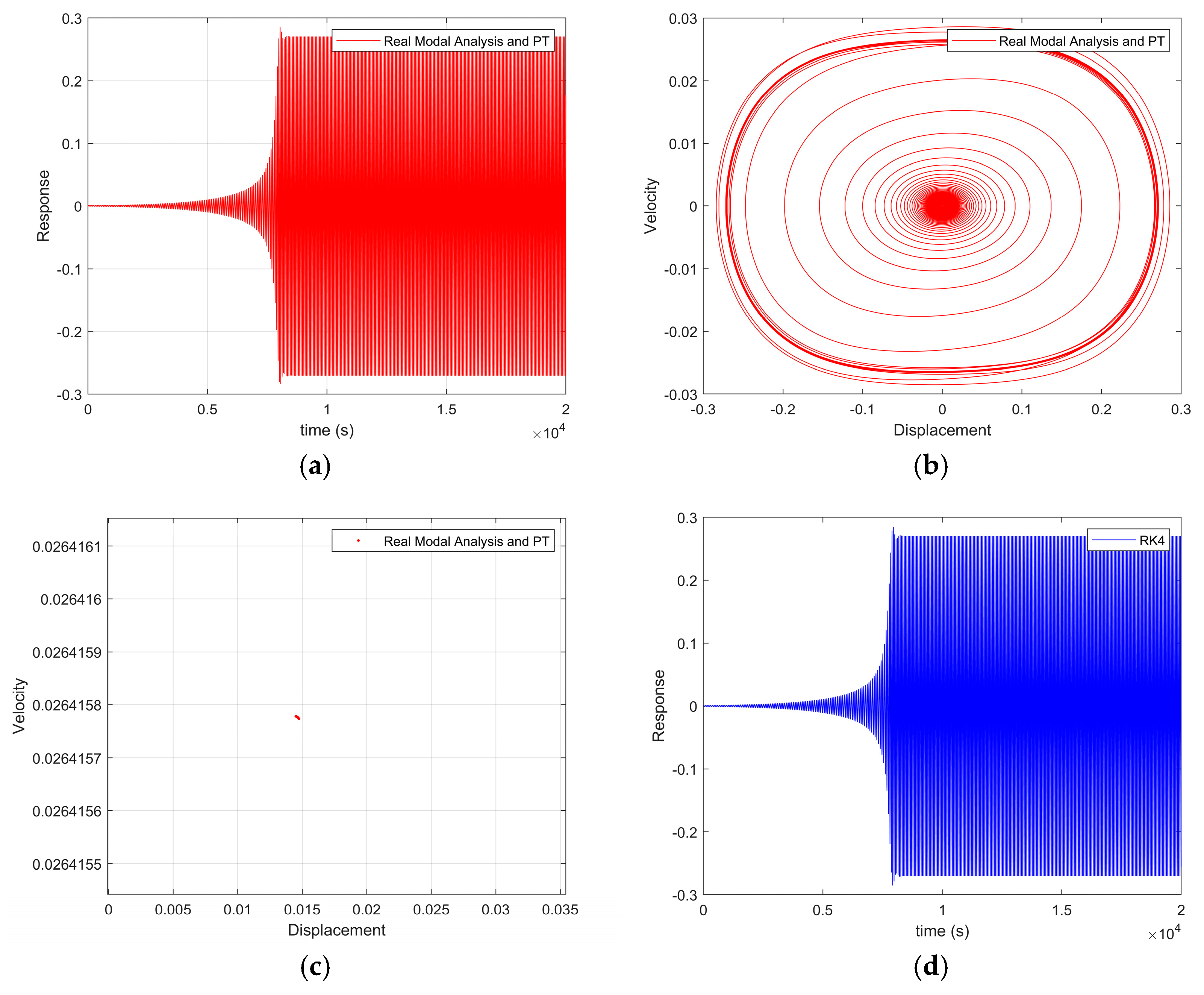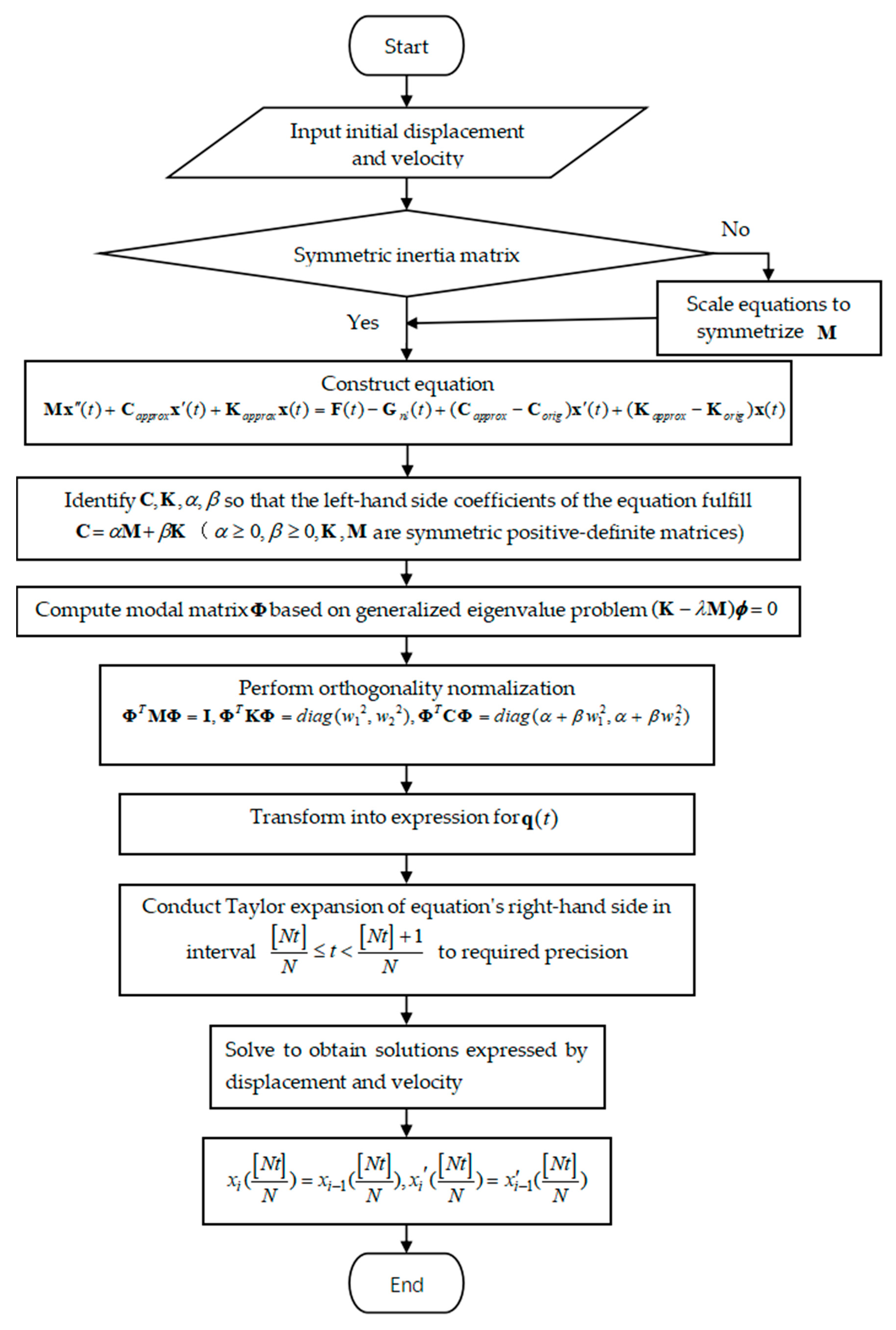3.1. Inertial Symmetric Coupled Nonlinear Vibration System
The interaction of the mass term in inertially coupled nonlinear systems makes it difficult to obtain an analytical solution directly, which makes its solution difficulty far exceed that of traditional dynamic equations. For this difficult problem, in this paper, real modal analysis combined with the P-T method is adopted to effectively solve the problem of the inertially coupled nonlinear system, and the effectiveness of this method is verified through the two-dimensional airfoil vibration model. The two-dimensional airfoil vibration model features inertial coupling and nonlinear characteristics. The dynamic behaviors of the system, such as bifurcation and limit loop oscillation, have been widely studied, providing a sufficient benchmark for method validation. For the inertially symmetric coupled nonlinear vibration problem, the classical model of two-dimensional wing flutter can be adopted for description [
26]:
Among them,
is the vertical displacement,
is the rotation Angle,
is the flow velocity, and the dimensionless flow velocity
is introduced. Other parameters are taken from reference [
27],
,
,
,
,
,
, and
, and we obtain:
Suppose the rotation Angle
of the system has a cubic nonlinear term, then
,
, the system equation is written as:
Equation (25) represents an inertially coupled nonlinear vibration system. Decoupling of coupled problems often employs real modal analysis. From the derivation in
Section 2.1, it is known that the conditions for applying real modal analysis are that
and
are symmetric positive definite matrices, the damping matrix
is a
symmetric matrix, and the proportional damping a is satisfied. Therefore, to construct a system matrix suitable for real-mode analysis, it is necessary to first construct the left side of the equation into a structure that satisfies the form of proportional damping, and any redundant terms generated during the construction process should be moved to the right-hand side of the equation. In addition, we must minimize the differences between the coefficients
,
and
on the left side of the equals sign and the coefficients of the corresponding terms in the original equation as much as possible. This is because the P-T method uses Taylor series expansion for the right-hand side of the equation, and larger differences on the left-hand side result in greater errors. Since Equation (25) does not satisfy proportional damping
, the proportional damping is constructed as follows:
The structure of Equation (27) satisfies the conditions for the real modal analysis. Ignoring the expression on the right-hand side of Equation (26), decouple Equation (28):
Based on the modal orthogonality of the symmetric system, the modal coordinate transformation
is carried out, and the characteristic equation
of the generalized eigenvalue problem is solved to obtain the modal matrix:
To obtain
, normalize
:
The modal matrix
performs coordinate transformation on the mass matrix
, damping matrix
, and stiffness matrix
to obtain:
Decouple Equation (28) on the left side:
The modal equation is obtained from the modal matrix:
Solving Equations (26), (32) and (33) yields the following system of equations:
After decoupling the inertial term, it is solved using the P-T method. For convenience of representation, Equation (34) is written as follows:
Since the 3rd order can achieve the required accuracy in this example, the high-order term of Equation (35) is truncated after being expanded at the
th time interval
:
The solution within the
th time interval is generated using the P-T method, as shown below:
Since the function is continuous within the interval
, where
, it should satisfy the following expression:
Based on the above recursive relationship, the solution of the system can be obtained. Numerical simulation of the system was conducted and compared with the time-domain minimum residual method (TMRM) calculation results at N = 12 in reference [
27], resulting in
Figure 1 and
Table 1 of the
curve.
The black dots in
Figure 1 represent the
values calculated by the TMRM when N = 12, while the red line shows the
values obtained by combining the real modal analysis with the P-T method. As shown in
Figure 1 and
Table 1, the displacement-time diagrams calculated by the real modal analysis with the P-T method and those by the TMRM are nearly identical, with minimal numerical differences in the solutions. For ease of analysis,
Table 2 provides the computational time and error.
As shown in
Table 2, it is evident that the CPU computation time for the real modal analysis combined with the P-T method is shorter than that of the TMRM when N = 12. The average relative error of the solution is less than 3%, with a maximum relative error of less than 10%. This indicates that the time-history response obtained by combining the real modal analysis with the P-T method aligns well with that of the TMRM. The combination of the real modal analysis and the P-T method achieves an ideal balance between efficiency and accuracy. This characteristic of achieving significant performance improvement while ensuring calculation accuracy makes the combination of the real modal analysis and the P-T method have important research value and application potential.
To verify the reliability of the method proposed in this paper, this section first analyzes a benchmark case. In this case, under the condition that the dimensionless flow velocity parameter is equal to 8, the solution obtained by combining real-mode analysis with the PT3 method was quantitatively compared with the semi-analytical solution obtained by the TMRM in reference [
27], and the error results are shown in
Table 2. The verification of this benchmark case has laid a foundation for the subsequent study of the dynamic characteristics of nonlinear inertial coupling systems with multiple parameters. The subsequent research mainly analyzed the dynamic behavior of the system under different parameters, and the results were verified by comparing the phase diagram with the reports in reference [
28] to see if they were consistent.
To explore the dynamic characteristics of the inertially coupled nonlinear vibration system, this paper comprehensively employs methods such as time history diagram, phase diagram, Poincaré mapping, and Periodicity Ratio. Multiple methods corroborate and complement each other, jointly revealing the evolution process of the system from periodic motion to a chaotic state.
Firstly, the time history diagram provides the most intuitive initial judgment. It shows through the displacement variation curve over time how the system motion evolves from a regular periodic waveform to irregular oscillation through period-doubled bifurcation. The phase diagram reveals the global form of the system’s motion through the relationship between displacement and velocity. Its motion curve evolves from the periodic motion of a closed curve to a chaotic motion with complex, disordered, and never-repeating curves. When the system motion is extremely complex, it is easy to misjudge the dynamic behavior merely based on the time history diagram and phase diagram, while the Poincaré mapping provides a decisive objective basis for accurate judgment. It transforms continuous trajectories into discrete point sets. Periodic motion corresponds to a finite number of discrete points; for instance, one point corresponds to period 1 motion, and two points correspond to period 2 motion. Quasi-periodic motion is manifested as a closed curve loop, while chaotic motion is represented as a dense point cloud with a complex structure.
To obtain a quantitative indicator that does not rely on subjectivity, this paper adopts the periodic ratio proposed in reference [
23]. This method calculates a value between 0 and 1 through the formula
, where
is the total number of all points in the Poincaré mapping and
is the number of overlapping points.
represents perfect periodic motion,
represents complete aperiodic motion, and
indicates motion that lies between perfect periodic motion and complete aperiodic motion.
Based on the above methods, we conducted an in-depth analysis of the dynamic behavior of the system under different dimensionless flow velocities.
The periodicity ratio of the system is determined to be 1 by the periodicity ratio method [
23], so the system is undergoing periodic motion. In
Figure 2, (a) shows a phase diagram and (b) shows a Poincaré mapping diagram. The phase diagram is a closed curve. There is a red point in the Poincaré map. Combined with
Figure 1, it can be seen that the system moves along a closed curve with a period of 1, and the trajectory has a slight convergence trend.
The periodic motion dynamic behavior of the inertially symmetric coupled nonlinear vibration system has been analyzed in the previous text. However, when the parameters change further, the periodic motion may no longer be stable, and the system may enter a more complex dynamic state. Research shows that, when the periodic solution undergoes an infinite number of multiple periodic bifurcations, the system will eventually enter a chaotic state. The unpredictability of the chaotic state and its sensitivity to the initial conditions will have an impact on the system’s behavior.
To deeply research the dynamic characteristics of the system, this paper combines the theoretical analysis and numerical results of the existing literature and conducts systematic research through methods such as bifurcation diagrams, time history diagrams, phase diagrams, Poincaré mapping diagrams, and periodicity ratios. In the existing research literature, many scholars have constructed inertially symmetric coupled nonlinear vibration systems. Among them, the equations of different motion types established by LC Zhao et al. [
28] in their research on analyzing the chaotic behavior of two-dimensional airfoil self-excited force systems are representative. This article will take this system of equations as the entry point to further explore the motion laws of the system. In this paper, the key parameter 0.04 before
in the second equation of Equation (24) above is adjusted to 0.07, resulting in the following set of equations:
Bifurcation is a core concept for understanding the dynamic behavior of nonlinear systems. It is a phenomenon where the qualitative behavior of the system undergoes a sudden change when the system parameters continuously vary. Because this mutation is very complex, it is difficult to intuitively perceive the characteristics of this dynamic evolution merely through mathematical equations. Bifurcation diagrams, as an important tool for nonlinear system analysis, can obtain the mapping relationship between the visual parameter space and the system state. This paper selects typical bifurcation scenarios of one-period, two-period, four-period, and chaotic motion, and analyzes the corresponding relationship between bifurcation point parameters and the dynamic behavior of the system through the bifurcation diagram (
Figure 3).
It can be seen from the bifurcation diagram that there are two points at the beginning of the system, which indicates that there are two different peaks in the system within the same period. At this point, the system is about to bifurcate into a 2-cycle for the first time. Subsequently, a second bifurcation occurs, entering a 4-cycle, after which the bifurcation rate accelerates sharply, quickly entering a chaotic state.
It can be seen from
Figure 4 that the system is in a stable periodic motion state. The periodicity ratio of this system is 1. The system repeats the same motion over time with a period of T. The phase diagram is a complex closed-loop curve, and the Poincaré mapping diagram is a point, so this system is in period 1 motion.
As the dimensionless flow velocity gradually increases, the originally stable periodic motion of period 1 changes, with the original motion becoming unstable and bifurcating into two new stable points. When
Q = 15.2,
Figure 5 is obtained. The system’s periodicity ratio is 1, and the system’s period doubles to 2T, with the system repeating the motion twice within each period. The phase diagram consists of two closed loop curves, indicating that the system has two distinct periodic motion modes. The Poincaré map consists of two points, so the system exhibits period-2 motion.
As the dimensionless flow velocity increases further, the period-2 motion loses stability again, and the system evolves from period-2 motion to period-4 motion through a double-period bifurcation, which is the path leading to chaos. At that time,
, resulting in
Figure 6. The periodicity ratio of the system is 1, and the period doubles again to 4T. In the time history plot, the waveforms of every four periods are consistent within the error range. The phase diagram consists of four closed loop curves, indicating that the system has four distinct periodic motion modes. The Poincaré map consists of four points, so the system exhibits period-4 motion.
As the dimensionless flow velocity continues to increase, period-doubling infinite bifurcation occurs, eventually transitioning to chaotic motion. When
,
Figure 7 is obtained. The periodicity ratio of this system is 0, and the system undergoes irregular motion over time, with the phase diagram exhibiting a complex and irregular tangled structure. The Poincaré mapping graph changes from four points to a dense point graph with disordered distribution.
Under the condition that the system parameters satisfy Equation (40), the numerical simulation results show that, as the dimensionless flow velocity increases, the system eventually enters a chaotic state through period-doubling bifurcation. The time history diagram changes from a regular periodic waveform to an aperiodic oscillation, the phase diagram transforms from a simple closed curve to a complex disordered curve, and the Poincaré mapping changes from a finite number of discrete points to a dense point cloud, clearly presenting the dynamic evolution process towards chaos. This numerical simulation result is in complete agreement with the theoretical analysis conclusion.
3.2. Inertial Asymmetric Coupled Nonlinear Vibration System
The previous text conducted an in-depth analysis of the dynamic behavior of inertially symmetrically coupled nonlinear vibration systems. In this research, based on the assumption of symmetry of the inertia matrix, the system decoupling is achieved through orthogonal transformation, and the solution is obtained by using the real modal analysis combined with the P-T method.
Among the numerical methods for solving coupled nonlinear systems, common ones include the Runge–Kutta method, etc. These methods usually involve step-by-step iterative calculations based on discrete time steps, and the final results are a series of numerical solutions at discrete time points. However, the real modal analysis combined with the P-T method has significant advantages, as it can obtain the continuous solution of the system. This feature is of vital importance because continuous solutions can present the dynamic evolution process of the system over the entire period more completely and accurately.
To verify the feasibility of this method in inertial asymmetric coupled nonlinear systems, this chapter takes the complex dynamic response of binary wings in supersonic flows as the research object. Through the combination of numerical simulation and theoretical analysis, the dynamic behavior of the system is explored.
Here,
represents the vertical displacement,
is the pitch Angle,
is the dimensionless flow velocity, and other parameters are taken from reference [
20]:
,
,
,
,
,
,
,
,
,
. The initial condition of this system is
. The dimensionless motion equation of the wing is written as
Substituting the parameters, the dynamic equation is rewritten as
The mass matrix in Equation (42) is asymmetric and does not satisfy the premise of real-mode decoupling. The basic conditions for modal decoupling are achieved by converting the sub-diagonal coefficients of the inertia term into the least common multiple.
As described in
Section 3.1, construct the proportional damping term.
Decoupling the left side of the equation using the real modal analysis
Through the modal analysis, the dynamic equation can be rewritten as
The P-T method, combined with the real modal analysis, was used to perform a numerical simulation of the dynamic response curve
of the system, and the results were compared and analyzed with those obtained using the RK4 method. Using the numerical solution from the RK4 method as the reference, the maximum relative error and average relative error of the P-T method combined with the real modal analysis were quantitatively evaluated, resulting in the comparison curve
Figure 8 and error data
Table 3.
In
Figure 8, the black dots are the
values obtained by the RK4 method, and the red lines are the
values obtained by the combination of the real modal analysis and the P-T method. Judging from the contents presented in
Figure 6 and
Table 3, the time history graphs calculated by combining the real modal analysis with the P-T method and the RK4 method show a high degree of consistency and almost complete overlap. For the convenience of subsequent in-depth analysis, the relevant error data are listed in
Table 4.
It can be seen from
Table 4 that the maximum and average relative errors of the two methods are very small, indicating that the results obtained by the two solution methods are very close. The results of the real modal analysis combined with the P-T method are reliable and feasible for use in examples. The validity and accuracy of the real modal analysis combined with the P-T method were verified.
In this section, a dimensionless flow velocity parameter equal to 8.132 is selected as the benchmark case. The solution obtained by combining real-mode analysis with the PT3 method is compared with that of the RK4 method in reference [
20]. The error results are shown in
Table 4. After the method validation, this section further studies the dynamic characteristics of the system under different parameters. The dynamic results of all parameter cases are consistent with the description in reference [
20].
To explore the dynamic characteristics of inertial asymmetric coupled nonlinear vibration systems, phase diagrams and Poincaré mapping diagrams are drawn.
Figure 9 shows that the system exhibits damped oscillation behavior, with the amplitude gradually decreasing over time and eventually approaching a standstill. The Poincaré mapping diagram forms a continuous trajectory that converges inward, intuitively reflecting the evolution process of the system state towards the equilibrium point.
To research the evolution process of the system’s dynamic state, the value of the dimensionless flow velocity
V was adjusted based on reference [
20] to observe the changes in the system’s behavior. When
V gradually increases from 8.132 to 17.934, the system transitions from decaying oscillation to chaotic motion.
Figure 10 shows that the system exhibits the characteristics of micro-amplitude limit loop oscillation motion. It can be seen from the time history diagram (a) that the response gradually decays to a slight oscillation after periodic motion. The phase diagram (b) is shown as a closed loop, and there is one discrete point in the Poincaré mapping diagram (c). Combined with the periodicity ratio being 1, it can be known that the system tends to the stable limit cycle.
Figure 11 shows that the system initially performs divergent motion. From the moment t = 8038 s, the system’s motion state changes and eventually enters a stable periodic motion. The time history diagram (a) shows that, after the system response diverges, it enters a regular periodic oscillation. In phase diagram (b), when the trajectory expands outward from the center, it corresponds to the divergence stage, and then gradually contracts and eventually converges into a stable closed curve. The Poincaré mapping diagram (c) shows that there is only one mapping point in the stable motion stage. Combined with the periodicity ratio being 1, the system performs a period 1 motion.
The time history diagram (a) in
Figure 12 shows the response to irregular fluctuations, the phase diagram (b) shows complex intertwined trajectories, and the Poincaré mapping (c) shows that a large number of non-repetitive trajectory points converge into a structurally complex dense point cloud. It is indicated that the system has chaotic characteristics [
29], is sensitive to initial conditions, and its long-term behavior is unpredictable. Combined with a periodicity ratio of 0, the system performs chaotic motion.
This paper reveals the transition path of the system from periodic oscillation to chaotic oscillation by varying the dimensionless flow velocity and combining multiple analytical methods, including time history diagrams, phase portraits, Poincaré maps, and Periodicity Ratio. As shown in
Section 3.1, the system undergoes a typical period-doubling bifurcation, where period-1 motion evolves into period-2 motion, then into period-4 motion, and finally leads to chaos.
Section 3.2 further demonstrates the dynamic evolution process from convergence, limit cycle oscillation, and periodic motion, to chaos. These results collectively prove that the dimensionless flow velocity is a key control parameter affecting the system’s transition from regular motion to chaotic motion.
To verify the reliability of the theoretical analysis results, by graphically comparing the calculation results of the real modal analysis combined with the P-T method with the literature, it was found that panel (c) of
Figure 1 in the literature [
20] misjudged the motion of the system as divergent motion due to insufficient simulation time (t = 3000 s). This research found that by extending the simulation time to t = 20,000 s, the system exhibited periodic motion (
Figure 11). To exclude methodological specificity, we adopted RK4 for verification under the same duration, as shown in
Figure 11d. The results indicate the system ultimately stabilizes, completely consistent with the results obtained by this paper’s real modal analysis combined with the P-T method. This correction reveals the limitations of short-term numerical simulation in nonlinear systems and emphasizes that fully extending the observation time plays a decisive role in accurately identifying the steady-state behavior of the system.
Except for the revised
Figure 11, all the other figures show good consistency. This comparison result not only fully verifies the computational accuracy of the real modal analysis combined with the P-T method in solving the dynamic response problems of such nonlinear systems, but also further supports the aforementioned theoretical analysis conclusion on the evolution of the system with dimensionless flow velocity.
To facilitate the understanding of the specific process of the combination of Real Modal Analysis and the P-T method,
Figure 13 provides the following flowchart for elaboration.
